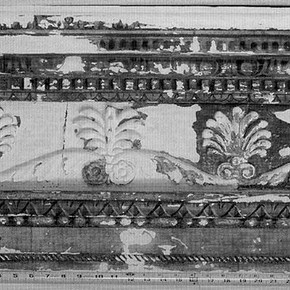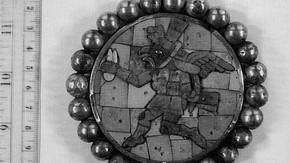Conservation Journal
January 1994 Issue 10
The Sherman Fairchild Center for objects conservation: Metropolitan Museum of Art, New York
In September last year I was given the unique opportunity to undertake a nine month internship within the department of Objects Conservation at the Metropolitan Museum of Art, New York. The internship allowed me to work with a wonderful variety of objects and to develop my skills in a new and stimulating environment. Given the different approaches to conservation and types of treatments employed in Europe and the United States, it also served to improve my knowledge of conservation practice.

Fig. 1. Gubbio Studiolo Project. Detail of cornice after an application of calcium carbonate gesso. (click image for larger version)
The Sherman Fairchild Center for Objects Conservation is responsible for the preservation and technological study of three dimensional works of art, namely metalwork, wood, stone, ceramic, glass, sculpture and furniture. Ten of the Museum's seventeen curatorial departments are serviced, those being the Egyptian, Asian, Greek and Roman, Ancient Near East, Islamic, European Sculpture, American Decorative Arts, Medieval, Twentieth Century Art and the Arts of Africa, Oceania and The Americas (AAOA). The department is independent in regard to budgets, policies and location from the Paintings, Textiles and Paper conservation sections. Also separated is the Arms and Armour restoration department.
Object conservators specialise in both cultural areas as well as in material divisions as at the V&A. Curators and conservators collaborate on conservation practice, and also budgets and contract employment for specific projects. Conservators are actively involved in the acquisition committees.
During my internship, sixty individuals were employed within the department, thirty three as permanent members of staff. All others were within contract, fellow research, internship and volunteer positions.
The Head of Department, Tony Frantz places a special emphasis on the role of technological, material and method research. Conservation posts are available for research; recent investigative studies include the assessment of stone consolidants, fumigation techniques, BTA (Benzotriazole treatment for copper alloys, and technical studies of South American and Egyptian metallurgy.
Internships and graduate fellowships are promoted and I met individuals from Nigeria, Germany and the Slovak Republic. Several senior conservators teach at the nearby Conservation Center at New York University and graduates from the course participate in research undertaken within the department as well as work projects during their vacation period.
There are a high proportion of contract posts, for which conservators are hired on a project basis. Volunteers work within the department often seeking experience prior to enrolment in graduate school.
The new facility was planned and built over a seven year period at a total cost of approximately $10 million. The principal funding was provided by the Sherman Fairchild Foundation. The move from scattered and inadequate studios was completed shortly before my internship began, and in the new design an effort has been made to amalgamate the department whilst keeping incompatible functions separate.
The new studio space occupies three levels of the Henry Kravis Wing, in all approximately 27,000 square feet, and is positioned at the south west corner of the Museum. The levels are joined by a large freight and two passenger elevators, the latter also services public and staff access to galleries, curatorial departments and various function rooms.
The fifth floor is a beautiful open area with windows along the north side overlooking New York's Central Park. Electrical points are suspended from the ceiling together with solvent extraction facilities, movable tables support objects of art, microscopes etc. and tools are stored within portable trolleys. Because of the quality of natural light the area is ideal for inpainting and polychromy work. On the south side of the studio, offices and an administrative section neighbour a preparation laboratory.
The ground floor is the general conservation studio, and the area in which the majority of my work was undertaken. Occupying approximately 15,000 square feet the spacious plan comprises four interconnecting bays for the examination and treatment of works of art, adjoining offices, photography studios, a gilder's room, the principal laboratory and research facilities and a comprehensive library separated from a seminar/coffee room. Upon entering you pass the administrative section and central reception desk where staff record the movement of objects, and amongst other duties operate the intercom service that extends to all floors.
Consideration has been made for environmental control within work areas and filtered air is controlled with respect to temperature and relative humidity. Overhead flexible fume extraction is positioned within each bay, these large spaces are edged with in-built solvent resistant desks, and allow portable wooden tables to be arranged as necessary within the centre. The design intension is for a flexible space which can accommodate change: operation and numbers of conservators.
Individual rooms allow for specific work and house sophisticated scientific equipment, there are also two fully equipped preparation laboratories. Within the department scientific analysis is considered an essential part of any treatment procedure and scientific equipment is well represented. Instruments such as the Scanning Electron Microscope SEM) and an Energy-Dispersive Spectrometer (EDS) are contained so that neighbouring electrical fields or floor vibrations cannot interfere with results. The most generally used and non-destructive piece of apparatus at the V&A, the X-Ray Fluorescence did not exist, however they plan to acquire one.
A small cupboard room contains an X-Ray Diffraction (XRD) unit which is frequently used by staff for analysis of crystalline material. Under the supervision of Jean-Francois de Laperouse I gained practical experience in taking and analysing x-ray diffraction powder photographs of copper alloy corrosion products, whilst working on a project for the treatment of archaeological Near Eastern bronzes by Benzotriazole impregnation.
I also assisted senior conservators with taking and developing x-radiographs. A large 320kv Philips x-ray unit is housed within the department together with an x-ray darkroom and is widely used by many permanent members of staff. Two further rooms house metallographic facilities.
A sample preparation area is separated from the metallographic microscope to prevent the transfer of abrasives. There are two separate small photo studios plus colour and black/white film processing and printing labs. Conservators undertake all documentary photography themselves, and only for special problem solving and publication purposes do they involve museum photographers.
A level beneath the main studio contains the Installation Section, with four highly skilled members of staff. Here brass exhibition mounts are designed and made. There is also a separate room (equipped with overhead hoists) for the treatment of large stone sculpture.

Fig. 2. Ear spool from Loma Negra, North Peru, (3-6 century AD.). Gold with stone and shell inlays depicting a bird-headed winged runner. (click image for larger version)
My most focused project work was the treatment of archaeological metalwork originating from South America. Under the supervision of Ellen How I worked on two projects, the first involved treating a number of metal objects originating from Loma Negra, Northern Peru, a burial site from the Moche civilization which dates from 100-400 AD. These pieces were fascinating from the point of view of both materials and techniques.
Ceremonial artifacts and body ornaments were fabricated from base silvers or hammered sheet copper that had been gilded or silvered. They were incrusted with a range of corrosion products, chiefly oxides; red cuprite, and carbonates of copper; the blue mineral azurite and green malachite. Accretions relating to the burial such as textiles, feathers and shell fragments were preserved in or replaced by corrosion products causing treatment problems. Because of the saline burial conditions (a coastal desert region) chlorides of atacamie and nantokite were found neighbouring the accretions. Nantokie is unstable, exposed to air with a relative humidity as low as 50%, it quickly absorbs water, oxidizes to cupric chloride and swells turning to a pale powder (paratacamite or 'bronze disease'). Removal or chemical treatment would involve loss of accretions and therefore valuable information. Such considerations stressed preventive conservation measures, preferably to store/display within an environment of stable RH below 35%. The most intensive conservation treatment undertaken was the stabilization of fractures and breaks using a series of tiny nylon gossamer strips consolidated with Acryloid B-48N, this provided a unique adhesion, strong, flexible and reversible.
The second project involved preparing an important collection gifted to the Museum by Jan Mitchell for the permanent installation within The Precolumbian Gold Treasury. Approximately seventy gold objects ranging in origin from Costa Rica, Panama, Colombia, Ecuador, Peru and Argentina were surveyed. The majority of my work was non-interventive, consulting the installers on support requirements, I also gained a knowledge of the materials used for display within the Museum.
Furniture conservators are presently completing the conservation of the Gubbio Studiolo project, a small intarsia study built for the Duke of Urbino, Federigo da Montefeltro in the late 15th century for the Ducal Palace at Gubbio, Italy. The vast and detailed restoration project is in its fifth year and is three quarters completed.
I was fortunate to have the opportunity to work on two small projects both of which were connected with the polychromed ceiling of the intarsia room. The first entailed the delicate application of calcium carbonate gesso to areas of loss from original calcium sulphate gesso on the cornice. Secondly I treated a frame element from the little window ceiling involving isinglass consolidation of polychromy, rabbit skin glue consolidation of fragmentary poplar wood and the removal of deforming 19th century restoration gesso and bronze paint using a methyl cellulose gel revealing the original form, polychromy and craquelure gilding beneath. Research into the pigmentation and stratification of the polychromy was fully documented and I was able to study and photograph sample cross sections under a reflective light microscope in normal and uv light.
During my internship I therefore benefited from an immense diversity of activities as well as of objects, materials and methods of conservation. I extend my thanks to Tony Frantz, Ellen Howe, Dick Stone, J.F.Laperouse, Ton Wilmering, Mecka Baumeister, Pavol Andrasko, Debbie Schorsch, for their support, encouragement and for the immense amount I learnt under their supervision. Many thanks are also due to Jonathan Ashley-Smith, Diana Heath, The Armourers and Brasiers Foundation and The Kathleen and Margery Elliot Scholarship Trust without whose generosity this internship would not have been possible.
January 1994 Issue 10
- Editorial
- Conservation ethics workshop
- A curator's view of the ethics workshop
- Flattening large rolled paper objects
- Beating unwanted guests
- Stained glass in Eastern Europe
- The Sherman Fairchild Center for objects conservation: Metropolitan Museum of Art, New York
- RCA/V&A conservation course abstracts: materials & techniques essays 1992/3 & MPhil theses 1993